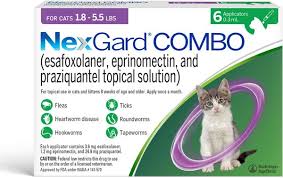How Long Is Nexgard Good for
NexGard, a popular flea and tick preventative for dogs, offers reliable protection against these pests. Understanding its effectiveness is crucial for pet owners. Typically, NexGard provides one month of protection against fleas and ticks. Administered orally, it quickly begins working, killing fleas within hours and ticks within a day. Its efficacy stems from Afoxolaner, an active ingredient that disrupts the nervous system of parasites. However, factors like the dog’s weight, metabolism, and environmental exposure can influence its duration. Regular administration following veterinarian guidelines ensures continuous protection, safeguarding your furry friend from infestations and potential health risks.
Key Takeaways
- Nexgard remains effective for up to 30 days after administration.
- Consistency in monthly dosing ensures continuous protection.
- Factors like pet’s weight and environment influence effectiveness.
- Monitor pet for signs of decreased efficacy and consult veterinarian.
- Active ingredients in Nexgard kill fleas and ticks effectively.
Duration of Nexgard Effectiveness
Nexgard typically remains effective for up to 30 days after administration. During this period, the active ingredients work to kill fleas and ticks on your furry friend effectively. It’s crucial to ensure you administer Nexgard regularly every month to maintain its efficacy in protecting your pet against these pesky parasites.
As a pet owner, you must follow the recommended dosage instructions provided by your veterinarian. Giving Nexgard to your pet at the same time each month helps establish a routine that ensures continuous protection. Remember, consistency is key when it comes to safeguarding your pet’s health and well-being.
If you ever notice any signs of fleas or ticks on your pet before the next scheduled dose, consult your veterinarian. They may recommend additional steps to address the issue promptly. By staying vigilant and proactive, you can help ensure that Nexgard continues to effectively protect your pet from flea and tick infestations.
Factors Affecting Nexgards Duration
Considering various factors can impact how long Nexgard remains effective in protecting your pet from fleas and ticks. The effectiveness of Nexgard can be influenced by your pet’s weight, as the dosage is based on this factor. Ensuring your pet receives the correct dosage is crucial for the treatment to remain effective.
Additionally, your pet’s exposure to fleas and ticks in different environments can affect how long Nexgard lasts. If your pet is frequently in areas where these parasites thrive, the duration of Nexgard’s effectiveness may be shorter.
Your pet’s overall health and immune system can also play a role in how long Nexgard remains potent. Pets with weakened immune systems may metabolize the medication differently, affecting its duration.
To maximize the effectiveness of Nexgard, it’s important to consider these factors and consult your veterinarian for guidance on the best dosing schedule for your pet.
When to Re-Dose Nexgard
To determine when to re-dose Nexgard, monitor your pet’s weight and exposure to fleas and ticks, as these factors can impact the duration of the medication’s effectiveness. Nexgard is designed to provide protection for up to 30 days against fleas and ticks. However, if your pet is consistently exposed to these parasites or has gained weight since the last dose, the efficacy of the medication may diminish before the 30-day mark.
If your pet spends a lot of time outdoors in areas where fleas and ticks are prevalent, it may be beneficial to re-dose Nexgard more frequently. Additionally, if your pet has gained weight, the current dosage of Nexgard mightn’t be as effective. In such cases, consulting your veterinarian for guidance on when to re-administer Nexgard can help ensure that your pet remains protected against these pesky parasites.
Monitoring Nexgards Efficacy
Regularly assess the effectiveness of Nexgard by observing your pet’s behavior towards fleas and ticks. Pay attention to any signs of scratching, biting, or skin irritation, as these could indicate that Nexgard may not be working as effectively as before. Keep an eye out for any fleas or ticks on your pet’s fur, as a sudden increase in these pests could signal a decreased efficacy of the medication.
It’s important to monitor how long Nexgard remains effective for your specific pet, as individual responses can vary. If you notice any changes in your pet’s reaction to fleas and ticks while on Nexgard, consult your veterinarian for guidance. They may recommend additional flea and tick prevention methods or adjust the dosage or frequency of Nexgard administration.
Nexgard Longevity Concerns
When addressing concerns about Nexgard’s longevity, it’s crucial to understand how the medication’s effectiveness may change over time for your pet. Nexgard is designed to provide reliable protection against fleas and ticks, but like all medications, there can be factors that affect its longevity.
One common concern is whether Nexgard’s efficacy may decrease over time, leaving your pet vulnerable to infestations. While Nexgard is generally considered effective for up to 30 days, some pet owners may worry about its potency towards the end of the dosing cycle.
It is important to note that Nexgard’s longevity can be influenced by various factors such as your pet’s metabolism, exposure to water, and overall health. Additionally, external factors like environmental conditions and the prevalence of fleas and ticks in your area can impact how long Nexgard remains effective.
To address longevity concerns, it’s advisable to consult with your veterinarian for personalized recommendations on Nexgard usage and to monitor your pet for any signs of decreased effectiveness.
Frequently Asked Questions
Can Nexgard Be Given to Puppies Under a Certain Age?
You can give Nexgard to puppies, but be sure to follow the age guidelines provided by the manufacturer. It’s important to consult with a veterinarian to ensure the correct dosage and timing for your puppy’s health.
Are There Any Specific Storage Instructions for Nexgard to Maintain Its Effectiveness?
To keep NexGard effective, store it in a cool, dry place away from direct sunlight and moisture. Follow the storage instructions on the packaging. Proper storage helps maintain the medication’s potency and ensures your pet’s safety.
Can Nexgard Be Used Alongside Other Flea and Tick Preventatives?
You can use NexGard alongside other flea and tick preventatives, but it’s always best to consult your vet first. Mixing treatments can sometimes lead to adverse effects or interactions, so professional advice is crucial.
What Should I Do if My Dog Vomits After Taking Nexgard?
If your dog vomits after taking NexGard, contact your vet for guidance. They can advise on whether to re-administer the dose or provide alternative solutions. Monitoring your dog’s health and seeking professional advice is crucial.
Is Nexgard Safe for Pregnant or Lactating Dogs?
If your dog is pregnant or lactating, consult your vet before giving NexGard. Safety concerns may arise, and professional advice ensures the well-being of both mother and puppies. Always prioritize your dog’s health.
Conclusion
Overall, Nexgard is typically effective for up to 30 days in protecting your pet from fleas and ticks. However, factors such as your pet’s lifestyle and environment can impact the duration of its effectiveness.
It’s important to re-dose Nexgard regularly as recommended by your veterinarian to ensure continuous protection. Keep a close eye on your pet for any signs of flea or tick infestation to ensure Nexgard is working effectively for your furry friend’s well-being.








